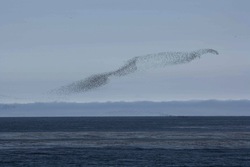Did A Vampire Just Turn Into A Colony Of Bats?
Classical Mechanics
Level
1
 The shape in the sky is:
The shape in the sky is:
a flock of birds.
a shadow.
a cloud.
a mirage.
This section requires Javascript.
You are seeing this because something didn't load right. We suggest you, (a) try
refreshing the page, (b) enabling javascript if it is disabled on your browser and,
finally, (c)
loading the
non-javascript version of this page
. We're sorry about the hassle.
The shape in the sky is a huge flock of starlings, which are small birds. The birds fly in a cohesive shape, staying together as they travel from spot to spot. It’s rather amazing that flocks of birds take such shapes, and it was a mystery for a long time how they go about doing so. A flock can make very quick turns, and so you might think there is some leadership structure in the flock where the bird in the front communicates a complicated set of directions to all the rest or that each bird has a large set of rules about what to do if the rest of the flock behaves in a certain way. It doesn’t work this way at all actually and, in fact, flocking is an example of an emergent phenomena, the exact opposite of a complicated rules based pattern.
Flocking behavior can be generated by three simple rules:
With these three rules that apply to each individual bird in the flock you generate complicated behavior: swooping around obstacles, landing and taking off together, etc. Note that the rules themselves make no mention of what to do in case of an obstacle. This is the hallmark of emergent behavior, where the macroscopic phenomena bears little resemblance to the microscopic rules. When the simple rules give rise to what appears to be large sale organized behavior, we call this “self-organization”. This is not limited to biology; self-organization occurs in the formation of convection cells in a fluid and in the Belousov-Zhabotinsky reaction in chemistry, where the microscopic chemical reactions combine to form ordered, macroscopic oscillatory phenomena.
From a mathematical and computational perspective, the most famous example of self-organization is Conway’s “Game of Life”, which is a type of cellular automata. The game of life is played on a n x n grid of cells, where each cell can be black or white. The game has a simple set of rules, whereby in each turn a cell turns black or white depending on what its surrounding neighbors do. Despite the mathematical simplicity, large patterns, sometimes consisting of thousands of cells, can be constructed that have a complicated behavior. For example, some patterns move, oscillate, breed, or launch other patterns repeatedly. These macroscopic patterns and their behavior constitute self-organization, or complicated phenomena that emerges from just some simple rules.
Further exploration: You can actually play the “Game of Life” online or with Golly. Golly is available on Android from the Google Play Store and iOS from the Apple store. An online version of the Game of Life can be found here .